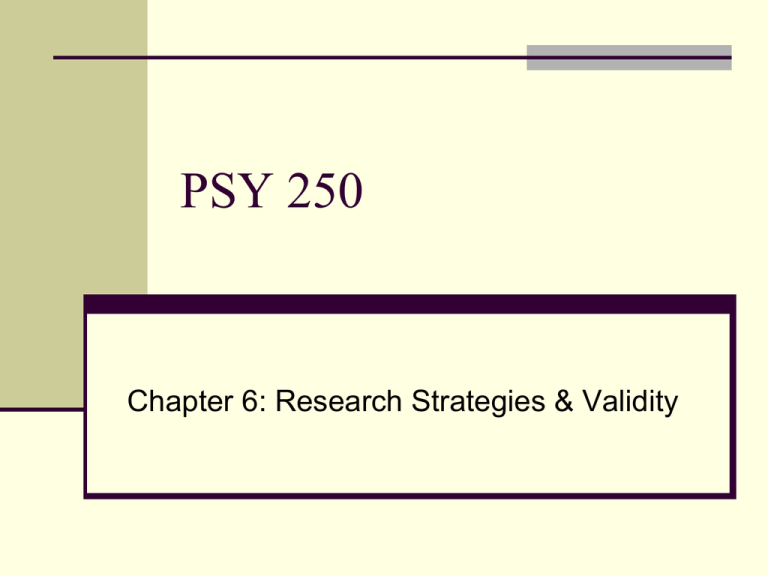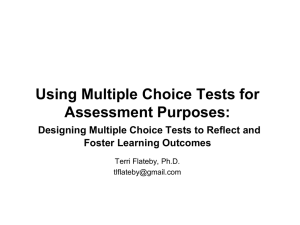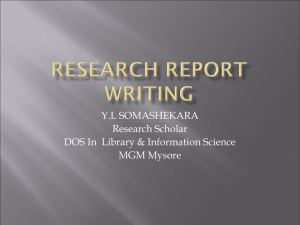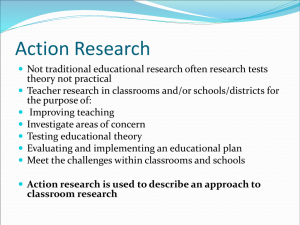Lecture 6 - Dr. Jennifer Vonk
advertisement

PSY 250 Chapter 6: Research Strategies & Validity Research Strategy General approach and goals of a study Dictated by question E.g. 1. 2. Is there a relationship between quality of a child’s breakfast and academic performance? Does improving the quality of a child’s breakfast cause an improvement in the level of the child’s academic performance? Experimental Research Strategy Designed to answer cause and effect questions about the relationships between two variables Conducted with rigorous control E.g. Low and high quality breakfast(IV) and academic performance(DV) Quasi-Experimental Research Strategy Designed to address cause and effect questions about the relationships between two variables Use some of rigor and control of true experiments but contain flaw that prevents absolute determination of cause E.g. compare pre-term and full-term infants in attachment with parents – can’t determine that being born full-term CAUSES more secure attachment Non-experimental Research Strategy Designed to answer questions about the relationship between two variables by demonstrating the difference between two groups or two treatment conditions Don’t use rigor and control Do not produce cause and effect explanations E.g. same question – but less control over extraneous variables like health, size of baby, SES, age of parents etc. Correlational Research Strategy Designed to answer questions about the existence of a relationship between two variables Can only describe, NOT explain relationship E.g. family income and academic performance Or mood and weight, success & esteem Descriptive Research Strategy Designed to answer questions about the current state of individual variables for a specific group of individuals Not concerned with relationship between variables E.g. different amounts spent on eating out, entertainment and clothing in different neighborhoods Two Research Strategy Classification Scheme Experimental vs. non-experimental or non- manipulative research Only Experimental strategy determines causal relationships Validity “the quality or state of being true” Dictionary definition The degree to which the study accurately answers the question it was intended to answer The correctness or truth of an inference Research definitions Threat to Validity Any factor that raises doubts about the quality of the research process or the accuracy of the results Internal Validity: Evaluating Your Experiment from the Inside Internal Validity Question of whether your IV actually caused any change that you observe in your DV. Single unambiguous explanation for the relationship between two variables If you use adequate control techniques, your experiment should be free from confounding (alternative explanations for your results) and you can, indeed, conclude that your IV caused the change in your DV. Threats to Internal Validity Any factor that allows for an alternative explanation E.g. Extraneous Variables Additional variables not directly investigated E.g. weather, light, time of day etc. Confounding Variables An extraneous variable that changes systematically along with the variables being studied E.g. increasing temperature along with time (fatigue) in study of problem-solving Threats to Internal Validity 1. Environmental Variables Threats to all studies Size of room, time of day, temperature etc. Coke vs. Pepsi study example Threats to Internal Validity 2. Threats to Studies Comparing Different Groups Assignment Bias Process used to assign different participants to different treatments produces groups of individuals with noticeably different characteristics Threats to Internal Validity Selection If we choose participants in such a way that our groups are not equal before the experiment, we cannot be certain that our IV caused any difference we observe after the experiment. Interactions with Selection Interactions with selection can occur when the groups we have selected show differences on another variable (i.e., maturation, history, or instrumentation) that vary systematically by groups Threats to Internal Validity Mortality/Attrition Mortality can occur if experimental participants from different groups drop out of the experiment at different rates. Threats to Internal Validity Diffusion or Imitation of Treatments can occur if participants in one treatment group become familiar with the treatment of another group and copy that treatment. Threats to Internal Validity 3. Threats to Internal Validity for Studies comparing One Group Over Time Other time-related variables could be confounding variables E.g. daylight, temperature Time-Related Threats to Internal Validity History History refers to events that occur between the DV measurements in a repeated measures design E.g. 1940 Nazi propaganda experiment Longitudinal attitude measurements Time-Related Threats to Internal Validity Maturation Maturation refers to systematic changes in participants’ physiology or psychology that occur over time during an experiment E.g. fatigue, boredom Time-Related Threats to Internal Validity Instrumentation Instrumental bias or instrumental decay Changes in a measuring instrument that occur over time Behavioral observations most susceptible Observers may become more skilled or fatigued Time-Related Threats to Internal Validity Testing Effects Testing is a threat to internal validity that occurs because measuring the DV causes a change in the DV. If your attention is being explicitly measured, you may be more attentive than you would be otherwise Time-Related Threats to Internal Validity Practice Effect A practice effect is a beneficial effect on a DV measurement caused by previous experience with the DV E.g. taking the GREs or SATs a second time Time-Related Threats to Internal Validity Carry-over effects Specific treatments cause changes in the next treatment(s) and alter the participants’ score NOTE: caused by experiencing a SPECIFIC treatment Time-Related Threats to Internal Validity Regression toward the Mean = Statistical Regression The tendency for extreme scores on any measurement to move toward the mean (regress) when measurement is repeated Stable factors remain constant but unstable factors can change substantially Esp. a problem when participants selected for extremely high or low scores Protecting Internal Validity How Important is Internal Validity? It is the most important property of any experiment. If you do not concern yourself with the internal validity of your experiment, you are wasting your time. External Validity The extent to which we can generalize the results of the study to other populations, settings, times, measures etc. Would the same results be obtained under different conditions? Threats to External Validity Any characteristic of the study that limits the generality of the results E.g. testing white middle-class children in urban area 3 Types of Generalization 1. From a sample to the general population 2. From one research study to another 3. From a research study to a real world situation Threats to External Validity 1. Generalizing across Participants Can results be generalized to individuals who differ from research participants Selection Bias Sampling procedure favors selection of some participants over others E.g. convenience of college undergraduates Volunteer bias Participant characteristics Cross-species generalizations Threats to External Validity 2. Generalizing Across Features of a Study To what extent can results be generalized to other procedures for conducting the study? Novelty Effect Behaviors of individuals in research study might differ from their behavior in real world due to novelty of test situation and defining and salience of treatment conditions Threats to External Validity Reactivity Reactive measures are DV measurements that actually change the DV being measured. Many attitude questionnaires are reactive measures. If we ask you a number of questions about how you feel about people of different racial groups, or about women’s rights, or about the President’s job performance, you can probably figure out that your attitude is being measured. Solutions to Reactivity Non-reactive methods Doesn’t alter participant’s response E.g. one-way mirrors, hidden cameras and microphones, naturalistic observation, deception etc. Less of an issue in field vs. laboratory settings Threats to External Validity Multiple Treatment Interference The potential influence of experience in earlier treatments Can the results of the treatment be generalized to those who have not received earlier treatments? Threats to External Validity Experimenter Characteristics To what extent can the results of the study be generalized to other experimenters? Demographic and personality variables Threats to External Validity 3. Generalizing Across Features of the Measures To what extent can the results of the study be generalized to other ways of measuring in the study? Assessment Sensitization Participants react differently to treatment b/c of the process of measurement Pre-test may make participants more aware of their own attitudes or behaviors Threats to External Validity Generality across Response Measures E.g. Physiological versus behavioral measures of a phobia – treatment can affect one but not the other Time of Measurement Threats to both Internal & External Validity Artifacts A non-natural feature accidentally introduced into something being observed dictionary An external factor that may influence or distort the measurements Experimental E.g. A Dr.’s ice-cold stethoscope Artifacts cont. Experimenter Expectancy Experimenter’s beliefs or expectations regarding the outcome of the study influence the results of the study Paralinguistic cues Kinesthetic cues Verbal reinforcement Misjudgment of participants’ response in direction of desired or expected results Errors in recording participants’ response in direction of desired or expected results Artifacts cont. Demand Characteristics Cues from the research situation that make it obvious what the purpose and hypothesis of the study is, and may influence participants to respond or behave in a particular way Subject Roles Good Subject Attempt to corroborate experimenter’s hypothesis Negativistic Subject Attempt to refute experimenter’s hypothesis Faithful Subject Follow instructions and avoid acting on suspicions Apprehensive Subject Overly concerned with their performance evaluations Exaggerated Variables Maximize differences for one of the variables (between treatment conditions) to increase likelihood of revealing relationship with second variable Research Design How to implement the study – general design Group vs. Individual Same vs. different individuals Number of variables to include Research Procedures Exact, step-by-step description of a specific research study How will variables be manipulated, regulated and measured How many individuals involved How participants proceed through study






